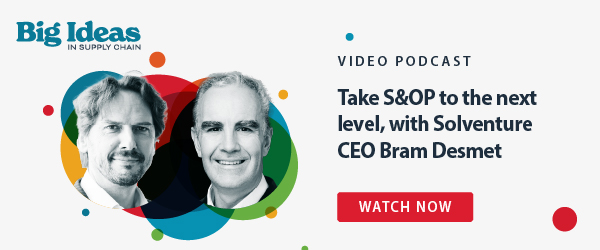Hundreds of millions of dollars are being spent on sales and operations planning (S&OP/IBP), yet according to Bram Desmet, author, and CEO of Solventure, less than 5% of companies have an S&OP or IBP process that’s mature enough to handle today’s biggest supply chain planning challenges. The problems are multi-faceted that includes lack of organizational alignment, no financial integration, poor implementation of planning systems and poor master data.
Is it time to abandon the concept of S&OP and start from scratch? In our recent Big Ideas in Supply Chain podcast conversation, Desmet says doesn’t believe so. In fact, he strongly believes that as a business process S&OP has never been more critical than it is today.
To start using S&OP to its full potential, companies need to upgrade capabilities in the following areas:
- Elevate S&OP/IBP so it is not just a supply chain process; it is a business process.
- End the separation of financial and operational planning processes because they need to be integrated.
- Everyone should aspire to have a level 5 S&OP where the organization is able to make value-based decisions.
Integrating finance’s input to create stronger S&OP processes
In many organizations, there’s a lack of trust between finance and supply chain teams. Traditionally, the two functions operated parallel to one another but in today’s ever-changing business landscape this arrangement is no longer acceptable. When external events require the agility to respond quickly and efficiently, it’s a major disadvantage if these two functions are not communicating and operating in tandem.
Finance is facing a disintermediation crisis. Many transactional roles are being replaced, and finance is looking for its new identity. Desmet says there is a potential risk of finance taking over the S&OP process, which he feels would not be an advantageous outcome. Successful S&OP relies on deep supply chain planning expertise, which the finance organization lacks – and in Desmet’s view, finance and supply chain need to partner to jointly create S&OP processes focused on value creation. "If we could link the operational knowledge of supply chain to the stature of finance in the organization, if we could simply combine the two, that's when we would really have an impact," says Desmet.
Also, technology has an important role to play, and AI will be a valuable tool to create better insights and support decision making. Traditionally, the S&OP process can take a month or more, which means data is already outdated by the time practitioners need to make decisions. New technology like AI can reduce that time considerably.
That said, Desmet does agree with the view that AI could make S&OP obsolete--but it does not help solve the dynamics in the executive team. Going forward, supply chain organizations will need to use a combination of human intelligence and artificial intelligence for best results.
The future of S&OP maturity levels
Desmet says S&OP is more crucial and essential than ever to balancing service, cash, and cost – but for it to be successful, companies must upgrade their material maturity level. Bram states that the ideal standard level that all companies should operate under is maturity level 5, which means organizations are connected to key customers, key suppliers, and can make value-based decisions based on the whole picture.
Speaking of the whole picture, Desmet is a big fan of the concept of Doughnut Economics: The safe space for humanity squeezed between an ecologic ceiling and social foundation, creating a more prosperous and balanced economic system for people and the planet. As the ecological ceiling comes down and the social foundations rise, organizations need to operate within these boundaries. S&OP becomes a vital part of this new operating model.
Given the changing landscape defined by doughnut economics, Desmet questions whether we need to rethink the traditional five levels of S&OP maturity – level 5 is focused on value creation, so do we need a sixth level focused sustainability?
Desmet says the industry should extend the maturity scale to encourage companies to do more. “If you look at sustainability, the maturity levels one to five don't really make the link to sustainability. So, if level 5 means we control the financial impact and we can make value-based decisions, maybe a level 6 would be that we say we can do that, but we also understand, for instance, the CO2 impact in the extended supply chain.”
To truly understand the CO2 impact on the end-to-end supply chain, Desmet acknowledges that more data is needed. Of course, the processes to collect, analyze and act on that data should be part of the theoretical level six.
As in all Big Ideas in Supply Chain podcasts, we ask what our guests would do if they were named the Chief Supply Chain Officer of the World. Desmet says he’d push for a new type of role for supply chain practitioners, given their pivotal role in moving value forward.
“Instead of being very reactive, (like) firefighters, supply chain people will become more proactive business managers,” he says. “We would not only have a huge financial impact from that perspective, but from that same role, we will also have a key contribution to sustainability objectives.”
Watch the entire conversation here:
For more on this topic, check out:






